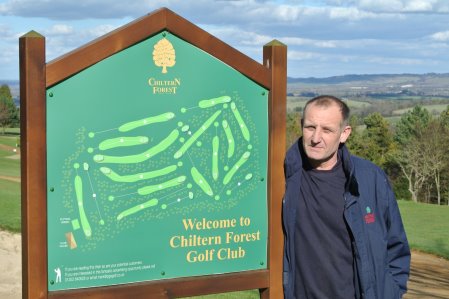
Head Greenkeeper Steve Horwood is working with Headland Amenity to achieve significant improvements to a tricky course while making savings on seed and chemicals that benefit the budget, the environment and the efficiency of his operations.
Chiltern Forest Golf Club is an 18-hole private members club in the Chiltern Hills of Buckinghamshire, part of which is chalk downland and the rest parkland. It was extended from 9 to 18 holes in 1992 on a tight footprint; the putting green was also rebuilt in 2004.
Facing north and high above sea level, the course is one of the last in the area to see the start of the growing season and one of the first to feel the grip of winter.
Head Greenkeeper Steve Horwood, who has been at the club for 10 years, comments that it was a big change from Gerrards Cross and Moor Park, his two previous clubs.
“I have had to adjust to the course in a very different way, and in fact the two parts of the course are quite distinct in their characters. The chalk downland has little topsoil and is very exposed with a constant breeze quickly drying out the soil, while at the bottom, greens are shaded and tend to be much wetter. There are also a few issues where greens were built using cut and fill and are a real mixture of materials,” he explains.
Steve aims to treat the course as one and offer the most consistent playing conditions possible, so soil testing is carried out each year and treatments programmed by Headland Amenity according to mean results from the samples.
As soon as the first signs of spring appear, Greentec 6-5-18 quick release fertiliser is applied to give the turf a quick start.
“We have a lot of poa annua/agrostis sward and it can look a little stressed coming out of winter so we aim to get this on in March, followed by Headlands Organic based C-Complex in April, which offers immediate availability of Nitrogen as well as some Organic Nitrogen and is applied at renovation.”
With the dry greens on the top of the course in particular, Tricure AD wetting agents play a vital role with applications starting in April and going through to winter, making the most of fertiliser applications and the good growing conditions. Tricure also improves water use after irrigation, vital on such free draining land.
Foliar feeding starts at the end of May, with Trisert-KS slow release, Solufeed NK water soluble fertiliser and Seamac Ultra Plus in a tank mix. Steve comments: “This is a flexible product combination and Seamac is a good biostimulant foliar. I tend to work by eye, and if I feel the turf needs something, will check with Iain Richardson at Headland and adjust the rates or application frequency to suit.”
Standard application intervals are four weeks, but in discussion with Iain, Steve is going to trial fortnightly applications at half rate this year. “In extreme conditions the sward can look a little pale and stressed, so we’re going to see if this will keep the playing surface more consistent throughout the season,” he explains.
In August, the programme switches to autumn foliar feed and plant protection products, with the aim being to prepare the turf for the rigours of winter.
“We had some serious issues with fungal disease in the past, so we are keen to keep the sward strong going into winter so that it can withstand conditions which predispose disease,” Steve explains. “If we can get the nutrition right, effective control of disease is possible without using too much fungicide. For the first two years I was here, fungal disease was rampant, but for the last five or six winters there has been hardly any.”
The programme includes Turfite, a phosphite plant elicitor which triggers the plant’s own immune system, Liquid Turf Hardener and Seamac Pro Turf, providing chelated iron, calcium, nitrogen and magnesium, nutrients needed to see the turf through the winter.
“While the course has traditionally looked very good through the summer, we are now getting a more consistent playing surface year round. In addition, we maintain a good density of sward through to the spring, so I just need to pick the grass up and get it going,” comments Steve. “It also means that less overseeding and top dressing is needed, which cuts costs further.”
Ongoing benefits, he points out, are reduced stress and improved condition of the sward which gets stronger each year with improved root growth and increased uptake by bent grasses.
A preventative approach is clearly reaping results: “Before we started this programme, Anthracnose could be seen in July, but now we do not need to consider disease management until much later. The aim is to keep the sward clean through the autumn and then with the temperature falling, few if any treatments are needed,” comments Steve.
“When using a curative approach, no sooner have you treated the sward than the disease starts to come back at it. With preventative action there is no waste and we have been able to cut our use of iprodione to 20 litres a year, which is a significant improvement.”
While Steve is clearly achieving great results with the Headland products, he reserves his greatest praise for the customer service on offer.
“They are not just great products, but the passion for and knowledge of the Headland range that Iain and the team show is impressive. I can always discuss any issues with the turf or ideas with Iain, and he will give the best advice possible on application rates, alternative products or timings according to the conditions. Working with Headland gives me a great access to technical backup and reassurance.”
Chiltern Forest Golf Club www.chilternforest.co.uk

